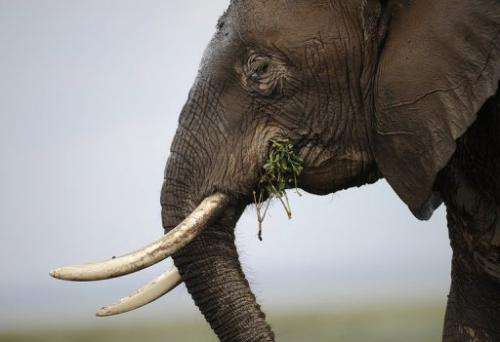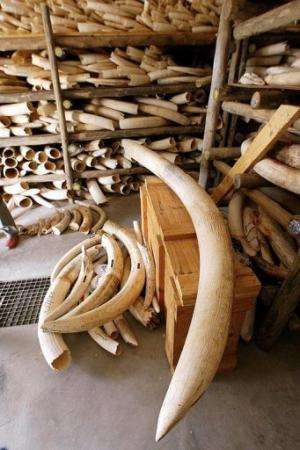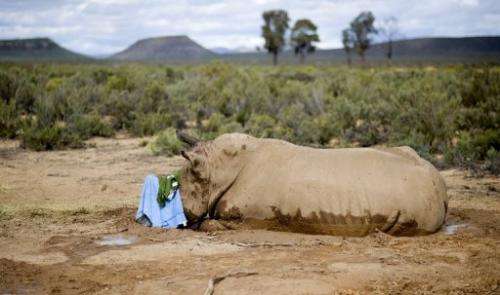Namibia offers model to tackle poaching scourge

Faced with poachers who are ravaging elephant and rhino populations, African nations could do worse than look to Namibia for a game plan to combat the scourge.
Wildlife poaching is on the rise across Africa's vast savannahs and in the jungles and outmanned and outgunned governments have struggled to keep up.
Last year saw a record 668 rhino killed in South Africa, according to the government, while in east Africa elephant killings increased apace.
The blame has been directed toward Asia, where demand for rhino horn, held to have medicinal value, is on the increase. Elephants are prized for their ivory tusks.
After several quiet years, Namibia too has been touched by the bloody uptake.
Late last year a black rhino cow was killed and dehorned in the south African country's remote and scenic northwest, her helpless calf left to die.
Though an isolated event, for Namibians, it was a rare and fearsome echo of the past.
For decades under South African rule, the country endured profligate poaching that threatened to exterminate wildlife populations and to discourage tourist dollars.
Today things are different.
Within days of the rhino's death, a culprit was arrested. A trial is now pending.
The apparent overnight success in tracking down the poacher was in fact due to decades of work.
It began 30 years ago when Garth Owen-Smith, a pioneer of community-based conservation, visited rural homesteads to encourage residents to cherish local wildlife.

His argument was simple: wild animals and farming people with livestock can not only co-exist but actually benefit each other.
Owen-Smith recalls his point in a recent book, "An Arid Eden," writing that "if the wildlife was conserved, it would one day attract tourists, creating jobs and bringing money to the area."
Local communities were initially reluctant to cooperate, but eventually the plan worked.
In 1980, Namibia had an estimated 300 black rhinos left. Today their numbers total some 1,700 animals.
Desert elephants were reduced to some 155 animals in the early 1980s and now they number around 600.
According to Pierre du Preez, current rhino coordinator for the ministry of environment and tourism, the policies worked partly because tracking animals for tourists provided well-paid jobs.
"Rural neighbours to rhino populations are far more pro-conservation, making it more difficult for individuals in these communities to become poachers as this might harm the whole community," he said.
"Better cooperation and trust exists between the (ministry), police, non-governmental organisations and the communities, thus the risk for illegal activities increases as the community will report to authorities."

The rhino poached in December was found by local people and immediately reported to officials.
This cooperation on the ground is being augmented with high-tech tactics.
"Security devices were implanted in a significant percentage of all rhino in high-risk areas, security personnel (are) specially trained and high-tech security systems are in place," Du Preez said.
An even more drastic measure may be on the cards. In 1989, Namibia was the first country in sub-Saharan Africa to dehorn black rhinos to prevent poaching. "This might become a possibility again," Du Preez added.
Namibia's success also shows the importance of tackling the politics that underlie and enable poaching.
In the 1970s and 1980s, Namibia's vast open spaces were effectively used as private hunting grounds by officials from the ruling South African government and top army personnel.
Officers visiting the war zones on Namibia's northern borders, where guerrillas of the South West Africa People's Organisation (SWAPO) were waging an independence struggle, would be treated to hunting trips with army planes and helicopters.
Temporary tent camps were set up and cabinet members from Pretoria including defence minister PW Botha—later South Africa's president—could even enjoy ice-cubes in their rum and coke or whisky.
The result was that hundreds of elephants, rhinos, giraffe and thousands of antelopes were shot for the pot, for illegal trade and for trophies.
Former prime minister John Vorster is thought to have shot an elephant by the Ombonde River in 1973.
When Namibia won its independence from South Africa in 1990, the government laid the groundwork for a new approach on poaching—"community-based natural resource management," a clumsy name for an effective policy.
Today, politicians may be able to set the stage for similarly successful polices by addressing demand for rhino horn at the source in Asia when signatories of the Convention on International Trade in Endangered Species of Wild Fauna and Flora (CITES)—a treaty to protect wildlife—meet in Thailand in March.
(c) 2013 AFP





















